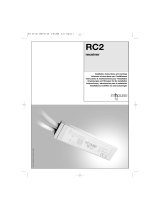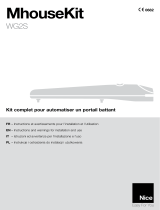Page is loading ...

DS1
Radio command digital selector
Use and installation instructions and warnings
Istruzioni ed avvertenze per l 'installazione e l'uso
Instructions et recommandations pour l’installation et l’utilisation
Anweisungen und Hinweise für die Installation und die Bedienung
Instrucciones y advertencias para la instalación y el uso
Instrukcje i ostrzeżenia w zakresie instalacji i użytkowania
Aanwijzingen en aanbevelingen voor installatie en gebruik
PUK CODE
IST191.4851 Rev. 01 del 28-04-2005

2
• Before starting installation, make sure that the prod-
uct is suitable for the intended use, giving particular
attention to the data indicated in the “Technical Spec-
ifications” chapter.
• MHOUSE are not responsible for damages caused by
the improper use of the product that is different from
that specified in the present manual.
• The packing materials must be disposed of in compli-
ance with local regulations.
• The digital selector must be kept at a sufficient distance
from heat sources and naked flames which could
cause damage, malfunctions or dangerous situations.
• WARNING: The digital selector batteries contain pol-
luting substances: do not dispose of them together
with other waste but comply with the methods estab-
lished by local regulations.
•
Specific warnings regarding the intended application of this
product in relation to the "R&TTE "1999/5/CE directive.
- This product complies with the essential requisites
specified by section 3 of the "R&TTE" Directive
regarding the use for which the product is destined
for in this instructions manual; the use of this product
for purposes other than those for which it was
intended is prohibited.
- The usable radio frequency range is subject to
national legislation; the countries in which this prod-
uct can be used are; all countries within the Euro-
pean Community and Switzerland.
- Those responsible for installation should verify if the
use of the products frequency is permitted, if the
country in which the product is to be used is not
mentioned in the point above.
1 Warnings
The DS1 digital selector (Fig. 1) is a radio transmitter
that, after having typed in the correct secret combina-
tion, permits the remote control of corresponding radio
receivers or gate or tubular motor control units and can
only be used for MHOUSE automation systems.
The combination is typed in by means of the 10 buttons
[X] in fig. 1 (from 0 to 9), while the 3 buttons [Y] in fig.
1 are used to send the 3 types of commands to a simi-
lar automation or to control up to 3 different automations
or receivers.
Another button [Z] in fig. 1 is used when there is little
light, which lights the buttons so that the combination
can be easily introduced.
A series of rapid Beeps confirms that the command has
been sent during transmission.
The DS1 has an IP protection level which makes it suit-
able for external use.
2 Product description and applications
Fig. 1
GB
X
Y
Z

3
If another remote control has already been memorised on
a control unit, radio receiver or tubular motor, the DS1
digital selector can be memorised as described below.
Whereas, if a transmitter has still to be memorised, the
instructions related to the product to be commanded
must be consulted to perform the “memorisation of the
first transmitter”; consult the site www.mhuose.biz if the
original instructions of the product are not available.
The memorisation procedure may change depending on
the product, therefore the original instructions should be
referred to.
A new DS1 digital selector can be memorised without
having to use the control unit buttons or the radio
receiver.
All that is needed is a working transmitter that has
already been memorised which we will call “OLD”.
DS1 “inherits” the characteristics of the OLD transmit-
ter. Therefore, if the OLD transmitter is memorised in
“mode I” then the DS1 will also be memorised in
“mode II”. In this case a transmission button of any of
the two transmitters can be pushed during the memo-
rising phase.
Whereas if the OLD transmitter is memorised in
“mode II” the desired command button on the OLD
transmitter must be pressed as well as the button to
which you wish to associate that particular command on
the DS1 transmitter.
5s
Table “A” Remote memorisation Example
1
Type in the secret combination (factory setting: “11”) on the DS1 digital
selector, then push a transmission button for at least 5” and then release.
X3
2
Slowly push the button on the OLD transmitter 3 times.
3
Type in the secret combination on the DS1 digital selector, then slowly
push a transmission button once (the same that was used in step 1), then
release it.
At this point the DS1 digital selector is recognised by the control unit, receiver or tubular motor and will take on the
same characteristics as the OLD transmitter.
Perform the following steps with the digital OLD transmitter and selector DS1 placed close to the control unit,
receiver or tubular motor:
Ideally a test should be made to ascertain the functioning and effective range before actually fixing the DS1.
The place in which the DS1 is to be fixed should also be carefully considered.
In addition to the distance from the receiver, avoid positioning it close to, or even worse, on metal structures that
could create a shield.
Place the DS1 digital selector on the wall to which it is to be fixed and perform a transmission to ensure that the
receiver receives the command that has been sent.
Also take into consideration that when the batteries are flat the range can be reduced by 25÷30 %.
Once the functioning has been assured, fix the DS1 at a suitable height as follows:
• Unscrew the retaining screw Fig.2
• Remove the base of the digital selector and screw it to the wall Fig.3
• Connect the digital selector to the support fixed to the wall, hooking it to the upper part of the support Fig.4
• Fix the selector to the support with the retaining screw Fig.5
4 Installation
Fig. 2 Fig. 3 Fig. 4 Fig. 5
3 DS1 remote memorisation
1 1
B
1 1
B

4
The DS1 digital selector emits a tone each time a button is pushed confirming that it has been performed correctly.
The DS1 cannot send a radio command until the command transmission has been enabled through the introduction
of the secret combination, after which the A B C buttons can be pushed to send the command as if the DS1 was a
normal radio transmitter.
The factory set combination of “11” can be changed at any time as described in the “Change of combination” chapter.
The secret combination is composed from a minimum of 1 number to a maximum of 10 numbers (for example: 5 or
5566778899).
If no buttons are pushed within 10 seconds the combination will have to be introduced once again in order to send
another command.
If the combination is incorrectly introduced, three rapid notes are emitted (beep-beep-beep) when the transmission
is attempted that indicate that the combination has been incorrectly typed in.
To make the introduction of the combination easier, the buttons can be lit up at any time by pushing button [Z] in
Fig. 1.
5 Usage
The secret combination can be changed at any time as long as the present combination is known.
To change the combination, proceed as described in table “B”.
6 Change of combination
Table “B” Change of combination Example
1
Push button [Z] of fig. 1
2
Type in the present combination
3
Push button [Z] of fig. 1
4
Type in the new combination (max 10 numbers)
5
Push button [Z] of fig. 1
6
Type in the new combination again (max 10 numbers)
7
Push button [Z] of fig. 1
8
Three beeps are emitted if the operation has been successful otherwise 5
rapid beeps are given indicating that one of the steps was unsuccessful.
NOTE: If one wishes to use DS1 without having to introduce a combination, a combination with no numbers can be
introduced by not pushing the buttons at points 4 and 6 of table “B”.
If the combination is forgotten it can be changed by repeating the above mentioned points and introducing the spe-
cial “PUK code” instead of the combination at point 2 of table “B”.
Each DS1 has its own individual 10 digit “PUK” code which can be found on the front cover of this manual.
1 1
1 2 3
1
2 3

5
When the digital selector range is significantly reduced and/or 10 rapid beeps are emitted when switched on, this
means that the batteries are flat and require replacement.
The digital selector contains two CR2430 lithium batteries.
If the DS1 is used in freezing temperatures (below -10°C) flat battery signals may be given even if the batteries are
still partially charged.
7 Replacement of the batteries
DS1 does not require any particular maintenance.
This product is made of various types of materials, some of which can be recycled while others must be disposed
of. Enquire about the recycling or disposal systems available in compliance with regulations locally in force.
Warning: some electronic components may contain polluting substances; do not pollute the environment.
8 Maintenance and Disposal
1) Unscrew the
retaining screw
2) Unhook the DS1
from the support
3) Unscrew the battery cap
4) Replace the old batteries
with new ones
5) Replace the
battery cap
6) Hook the DS1
to the support
7) Tighten the
retaining screw

6
Type:
Digital radio selector with digital combination for the control of awnings,
rolling shutters, gates and door automations.
AM OOK coded modulation of radio carrier.
433.92 Mhz
Rolling code with 64 Bit code (18 billion million combinations)
approx. 0.0001W
6V +20% -40% with two CR2430 type lithium batteries
2 years, estimated on the basis of 10 commands/day, each lasting 1” at
20°C (at low temperatures the efficiency of the batteries decreases)
9.999.999.999
-20 ÷ 55°C
No
DS1 is produced by NICE S.p.a. (TV) I, MHOUSE S.r.l. is an affiliate of the Nice S.p.a group.
Nice S.p.a., in order to improve its products, reserves the right to modify their technical characteristics at any time without
prior notice. In any case, the manufacturer guarantees their functionality and suitability for the intended purposes.
Note: all technical specifications refer to a temperature of 20°C.
9 Technical characteristics
DS1 is produced by NICE S.p.a. (TV) I, MHOUSE S.r.l. is an affiliate of the Nice S.p.a group.
CE Declaration according to Directive 1999/5/CE
Number 212/DS1/GB
Date: 02/02/2005 Revision: 00
The undersigned: Lauro Buoro declares that the following product:
Manufacturer’s name: NICE s.p.a.
Address: Via Pezza Alta 13, 31046 Z.I. Rustignè –ODERZO- ITALY
Model: DS1
Complies with the essential provisions of Section 3 of the European Directive R&TTE 1999/5/CE regarding the use
for which the product is destined.
Oderzo, 02/02/2005 Lauro Buoro
(Managing Director)
10 Declaration of Conformity
DS1 digital selector
Adopted technology:
Frequency:
Code:
Irradiated power:
Power supply:
Battery life:
No. of combinations:
Operating temperature:
Use in acid, saline or
potentially explosive atmosphere:
IP44 (for external use)
Protection class:
L 65 x H 95 x D 33 / 260g
Dimensions / weight:
/













